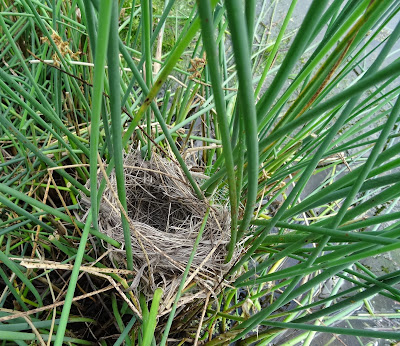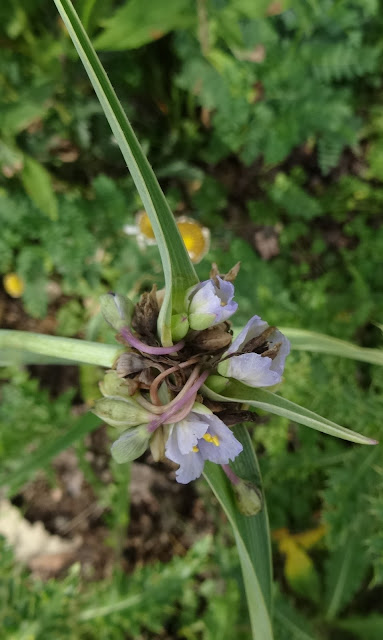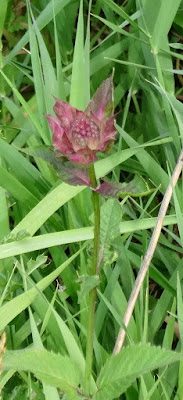This year December was a weird month weather-wise. The water level in the pond was lower every day, since we had no measurable snow this winter. Then on the December 25th it rained all day long. The next day, the water level had gone up and the log was again in the pond.
Wild Wild Woods
Woods, gardens, and wetlands with a naturalist-artist-gardener-writer.
12/31/2023
11/07/2023
new feathers
In November, Mallards paddle on the pond before they migrate to warmer places. The male Mallards molt their feathers in the autumn and regrow their green head feathers; in the following spring brilliant colors will help each male find a mate for the next breeding season.
10/11/2023
new logs, floating in the pond
The painted turtle Chrysemys picta is a native in Minnesota and of North America.
Painted turtles are active only during the day; they are warmed by their surroundings on sunny days by basking for hours on logs or rocks. On cloudy days or at night the turtle drops to the bottom of the pond. Painted Turtles eat aquatic vegetation, algae, and small water creatures including insects and crustaceans. They primarily feed while in water and are able to locate and subdue prey even in heavily clouded conditions.
9/25/2023
joe pye weed
This plant Eutrochium maculatum, is also called Spotted Joe-pye Weed, Purple Boneset, Spotted Trumpetweed. It is related to the similar Boneset which blooms white instead of purple or pink.
9/21/2023
cruising on a log
Painted Turtles line up on the shore to soak up the sun.
9/01/2023
duck house
We put up a nesting box for ducks last Spring, especially Hooded Mergansers.
It was too late for nesting season, but I read that sometimes they scout out in the autumn a place to nest next Spring.
We hope this female is scouting!
8/29/2023
8/10/2023
green heron
8/08/2023
7/30/2023
molting woodpecker
Mullein blooms over a long time in the summer. Some of the flower stalks have produced seeds. Birds molt old feathers and grow new ones after nesting and fledging their young. This Downy Woodpecker has a few more new feathers to sprout, but it is hungry enough to come out for lunch.
7/21/2023
empty nest
Cornell University has a program called NestWatch https://nestwatch.org/ where citizen scientists report on birds' nests they see. I missed this one until now; it was hidden very well in the reeds near the pond.
7/17/2023
fledgling robin
7/11/2023
7/09/2023
spiderwort
Critters have been eating plants and leaving evidence behind . . . broken off flower stalks, chewed reeds, left-behind stems, grass sheared off at ground level.
The muskrats swim across the pond to gather food on the opposite shores. The rabbits browse among the plants around the pond. I wonder who ate the Spiderwort?
7/04/2023
smooth oxeye
7/03/2023
bergamot
6/24/2023
dragonfly - Widow Skimmer
The widow skimmer Libellula luctuosa), part of the group 'king skimmer' dragonflies. It has large bulky body (compared to other species odonata) with large heads. This is a juvenile, with yellow with brown stripes.; when adult it will have a steely blue body. Wings are transparent, but marked with prominent black basal bands. Widow Skimmers are found commonly in muddy substrates, or still bodies of waters such as ponds. They prey on other smaller insects like mosquitoes.
6/22/2023
two killdeers
6/21/2023
6/17/2023
6/16/2023
killdeer
Killdeer Charadrius vociferus is a shorebird that is part of the plover family. About the size of a American Robin, it has very long legs and striped black and white neck. It usually inhabits grassy areas but eats mostly invertebrates. This one was foraging along the shore for aquatic insect larvae. The scientific name "vociferus" is from Latin; 'vox' meaning "voice" with 'ferre' meaning "to carry". Their call is surely carrying! https://musicofnature.com/mary-holland/killdeer/
6/10/2023
floating log
6/05/2023
prairie smoke gone to seed
We added Prairie Smoke Geum triflorum to the riparian area around the pond last year. They survived the winter, and bloomed mid-May.
Now each flower has transformed into clusters of feathery, wispy plumes that eventually will spread seeds as they wave in the breeze.
6/03/2023
blue flag
Northern Blue Flag Iris versicolor has a deep blue to purple flower. It is also called Harlequin Blueflag.
It grows on lake shores, swamps, pond edges, and wet meadows.
Blue Flag irises occur throughout the USA, in several varieties. Some plants are located on the south shore of the pond, and are blooming now.
5/29/2023
ox-eye daisy - invasive
Ox-eye Daisy Leuceanthemum vulgare is a perennial herbaceous species with a creeping root system.
This daisy is not native to Minnesota, but imported as an pretty ornamental flower.
It turned out to be an aggressive invasive species. Once established, it can spread rapidly by means of roots and seeds, and block sunshine for other native wildflowers.





























